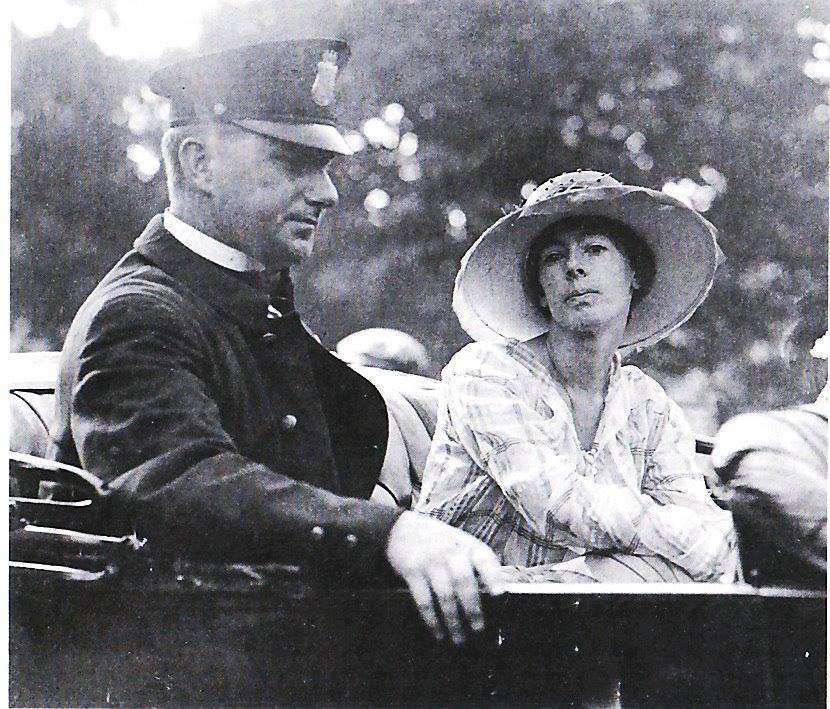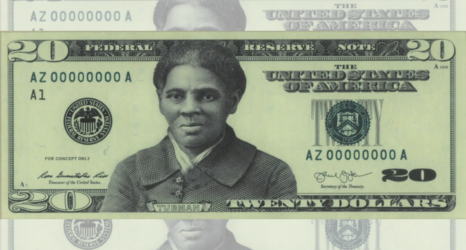
Today in Feminist History is our daily recap of the major milestones and minor advancements that shaped women’s history in the U.S.—from suffrage to Shirley Chisholm and beyond. These posts were written by, and are presented in homage to, our late staff historian and archivist, David Dismore.
June 22, 1917: After enduring bitter cold and snow, then rain, heat, humidity and attacks by unruly mobs over the past five months of picketing President Wilson by standing along the White House fence with protest banners, two members of today’s contingent of “Silent Sentinel” suffragists encountered a new challenge: arrests.

What was printed on the large banner that National Woman’s Party officers Lucy Burns and Katharine Morey were holding, which was considered so outrageous and offensive that it would cause their freedom of speech to be denied, and clearly ridiculous charges of “blocking traffic” on the wide sidewalks of Pennsylvania Avenue to be brought?
The following words:
“‘We shall fight for the things we have always carried nearest our hearts—for democracy, for the right of those who submit to authority to have a voice in their Government.’ President Wilson’s War Message, April 2nd, 1917.”
Apparently there is no law against embarrassing the President by pointing out the hypocrisy of his vigorously promoting democracy around the world while doing nothing to enfranchise millions of women in his own country, so “blocking traffic” had to do for an offense.
Seven police officers (six male, one female) singled out and surrounded Burns and Morey. Lucy Burns told the officers her banner was private property, and that they had no right to touch it. The woman officer than asked Burns if she wouldn’t rather give up the banner peaceably than be arrested. Burns replied that she had a right to stand there.
Both picketers were then arrested and driven off to police headquarters while some in the hostile crowd cheered, and others seemed to show support and admiration for the pickets’ courageous stand.
It is believed by National Woman’s Party leaders that President Wilson, as the highest-ranking member of his party, could significantly decrease the number of Democratic votes blocking the Susan B. Anthony Amendment in Congress if he used his full influence, so picketers have good reason to continue to prod him into action, despite the consequences to themselves.
With almost daily clashes now between banner-bearers and those who strongly object to anything that seems critical of our wartime President, the cause of suffrage is getting unprecedented coverage in the press. This delights those of us who think more militant tactics are called for, but not leaders of traditional suffrage groups who worry that the public can’t tell the difference between the two factions of “Votes for Women” advocates.
Officials of the National American Woman Suffrage Association long ago stated their firm opposition to picketing the President, and the New York State Woman Suffrage Party regularly issues strong condemnations of the protesters. So criticism of the White House pickets is coming from all sides, and must especially sting when it comes from fellow suffragists.
But the National Woman’s Party picketers feel that their tactics are as correct as their cause. Even after all these decades of work, women have won full voting rights in only 11 of the 48 States, plus limited suffrage in some others, and it could take many more decades to finish the job of nationwide enfranchisement of women by continuing with traditional methods.
The National Woman’s Party is not interested in endlessly repeating the process of working for years to get a suffrage referendum on a State ballot, then trying to lobby vast number of male voters, only to have suffrage rejected at the polls because of stereotypes about women, fear that women voters would ban alcohol—or myths about the disastrous effects equal suffrage would have on the family—and other such propaganda devices extensively used by anti-suffragists and backed by unlimited amounts of money from the liquor industry. Instead, the N.W.P. intends to concentrate its efforts on the President, then certain members of Congress, with the goal of getting the Anthony Amendment approved by two-thirds of the 435-member House and 96-member Senate, then sent to the States for approval by simple majorities of 36 State legislatures.
Two critical parts of Alice Paul’s ratification strategy are to make sure that the struggle for woman suffrage is constantly kept in the public eye, and to show that suffragists are a powerful force, with single-minded dedication to a goal, who will not let up until that goal is finally achieved. If court dates and prison sentences are now in the future for National Woman’s Party members, they appear willing to accept that as the price of progress. As long as they continue to have the courage to go with their convictions, the time until final victory will be shortened considerably by their personal sacrifices.
One indication that the National Woman’s Party will never sound “retreat” was just given, when it was announced here at N.W.P. headquarters that there will be a full contingent of pickets along the White House fence tomorrow, with new banners to replace those destroyed by earlier mob actions or confiscated by police.





